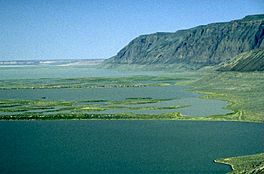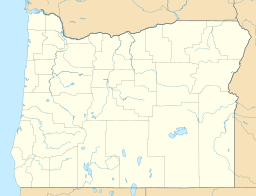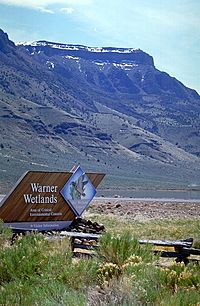Warner Lakes facts for kids
Quick facts for kids Warner Lakes |
|
|---|---|

Warner Lakes below Hart Mountain scarp
|
|
| Location | Lake County, Oregon, United States |
| Coordinates | 42°27′00″N 119°51′04″W / 42.44988°N 119.85106°W |
| Type | Endorheic lake |
| Primary inflows | Twentymile Creek; Deep Creek; Honey Creek |
| Primary outflows | None |
| Basin countries | United States |
| Max. length | 50 mi (80 km) |
| Max. width | 5 mi (8.0 km) |
| Surface area | 90,000 acres (360 km2) |
| Max. depth | 14 ft (4.3 m) |
| Surface elevation | 4,475 ft (1,364 m) at Hart Lake |
The Warner Lakes are a group of shallow lakes and marshy areas. You can find them in the Warner Valley in eastern Lake County, Oregon, USA. These lakes stretch across the valley. They cover about 90,000 acres (360 km²).
The lakes are named after Captain William H. Warner. He was an engineer who explored the Warner Valley. Sadly, he was killed by Native Americans in 1849. The Warner Lakes and the wet areas around them are home to many different birds and other animals. Much of the land around the lakes is public. It is managed by the Bureau of Land Management. These public lands offer fun activities. You can go hunting, fishing, bird watching, and camping there.
Contents
Exploring Warner Valley
The Warner Valley is located in south-central Oregon. It is about 60 miles (97 km) long and 8 miles (13 km) wide. Most of the valley is in Lake County. However, the northern part extends about 10 miles (16 km) into Harney County. This valley is a basin filled with many lakes. These lakes are what's left of a huge ancient lake. That lake once covered the valley floor up to 200 feet (61 m) deep. This was during the Pleistocene Ice Age.
Today, tall cliffs rise above a chain of lakes. These lakes have no outlet to the ocean. They are connected by wetlands. Together, they are known as the Warner Lakes. The valley has two main parts. These are the South Warner Valley and the North Warner Valley. They meet between Crump Lake and Hart Lake. At this point, the valley narrows to about 5 miles (8 km) wide.
Early People in Warner Valley
Native Americans used the Warner Valley's lakes and wetlands for thousands of years. They were here long before the first white explorers arrived. You can find many ancient rock carvings, called petroglyphs, near the lake shores. Some of these carvings are thought to be 12,000 years old. The Greaser Petroglyph Site is in the South Warner Valley. It is listed on the National Register of Historic Places. This means it is a very important historical site.
Naming the Valley and Lakes
In December 1843, Captain John C. Frémont led a group through the valley. Fremont and his team spent Christmas Day camping near Hart Lake. Because of the date, Fremont named the valley Christmas Valley. He called the lake Christmas Lake. However, early mapmakers made a mistake. They put Christmas Valley 60 miles (97 km) northwest of the Warner Valley. This left the actual Warner Valley and its lake unnamed on early maps.
In 1849, Captain William Horace Warner explored the valley. He was an Army engineer. On September 26, 1849, Warner was attacked and killed by Native Americans. This happened just south of the Warner Valley. In 1864, Lieutenant Colonel C. S. Drew visited the valley. He was on a scouting trip. Drew named the valley in honor of Warner. He believed Warner had been killed there.
Building the Stone Bridge
In 1867, General George Crook decided to build a fort in the Warner Valley. This was to stop Native American raiding parties from passing through. To get his wagons across the wet areas, he ordered a bridge to be built. It would cross a narrow, marshy channel between Hart Lake and Crump Lake. Forty soldiers from the 23rd Infantry Regiment were given this job. Captain James Henton led them.
The bridge was built between May 16 and July 24, 1867. It is known as the Stone Bridge. It was actually a quarter-mile-long raised road, called a causeway. Soldiers hauled basalt boulders and smaller rocks from nearby Hart Mountain. They dumped them into the marsh to build it. Today, the Stone Bridge across the Warner wetlands still stands. It is also listed on the National Register of Historic Places.
Lakes and Wetlands
Long ago, the entire Warner Valley was covered by one huge lake. Over time, the water level slowly went down. This left a chain of lakes in the lowest spots. Marshy land formed between the lakes. Today, the valley floor has a chain of lakes and wetlands. They cover over 90,000 acres (360 km²). This includes 52,033 acres (210.57 km²) that the Bureau of Land Management calls the "Warner Wetlands Area of Critical Environmental Concern."
There are many lakes in the Warner Lakes chain. Starting from the south end of the valley, the largest lakes are:
- Pelican Lake
- Crump Lake
- Hart Lake
- Anderson Lake
- Swamp Lake
- Mugwump Lake
- Flagstaff Lake
- Upper Campbell Lake
- Lower Campbell Lake
- Stone Corral Lake
- Turpin Lake
- Bluejoint Lake
The valley slopes towards the north. Because of this, Crump Lake is 123 feet (37 m) higher than Bluejoint Lake.
Water Sources for the Lakes
The Warner Lakes get their water from a few creeks. Twentymile Creek and Deep Creek feed the south end. Honey Creek flows into Hart Lake. Most of the water from Twentymile Creek goes into Greaser Reservoir. It also goes into irrigation canals in the South Warner Valley. Some of this water eventually joins Deep Creek and flows into Pelican Lake.
- Deep Creek flows into Pelican Lake all year. It provides much of the fresh water for the lake system. From the north end of Pelican Lake, a clear channel exists. It's a deep, winding ditch that goes through the marsh to Crump Lake.
- Crump Lake is named after Thomas Crump, who settled nearby in the 1890s. It is the largest of the Warner Lakes. It is about 7 miles (11 km) long and 3 miles (5 km) wide. Its surface area is about 7,680 acres (31.1 km²) at normal water levels. It is shallow. It keeps its level by overflowing into Hart Lake through a narrow, marshy channel. When Deep Creek has a lot of water, Crump Lake can overflow. This can flood up to 10,000 acres (40 km²) of the surrounding marshlands.
- Hart Lake is named after a heart-shaped brand. This brand was used by the pioneer Wilson and Alexander ranch near the lake. Hart Lake has the most stable water level in the Warner Lakes chain. It gets overflow from Crump Lake. It also receives a steady flow of fresh water from Honey Creek. The north end of Hart Lake can be around 14 feet (4.3 m) deep at normal water levels. The southern half of the lake is shallower. It averages only about 6 feet (1.8 m) deep.
- Anderson Lake is just north of Hart Lake. It is named after Thomas A. Anderson, who lived near the lake. The valley's water then flows into Swamp Lake and then into Mugwump Lake. The water level in Mugwump Lake can change a lot. It varies between the wet and dry seasons. This is why it was named after "mugwumps." These were political people who were independent and unpredictable.
- North of Anderson Lake, there are tall sand ridges. They are covered with greasewood plants. These ridges are between the lakes and marshy areas. Some are 50 feet (15 m) high. They form the shores of Flagstaff Lake, Upper Campbell Lake, Lower Campbell Lake, Turpin Lake, and Stone Corral Lake. The sand ridges are usually on the north shore of the lakes. This suggests the lakes might have been dry for long periods. During those times, winds from the southwest could have blown silt from the dry lake beds. This silt formed dunes, which then became the shoreline when the lakes refilled.
- Bluejoint Lake is at the very north end of the Warner Lakes chain. It is named after the bluejoint grass common in the area. Bluejoint Lake covers a large area, but it is very shallow. It is a lake that can be completely dry for long periods. This happens during times of low rainfall.
Hot Springs and Water Chemistry
Besides the fresh-water creeks, several hot springs also flow into the Warner Lakes. These hot springs come from cracks in the basalt rock layers deep below the valley floor. Their water temperature can be as hot as 160°F (71°C). Bacterial mats of green algae are common in the hot springs. Different types of algae grow depending on the water temperature and chemistry.
The hot springs add minerals that change the water chemistry of the lakes. From late spring through summer, the water in the lakes becomes more concentrated. This is due to evaporation. This process makes some areas of the lakes moderately to highly alkaline.
There is no outlet for the Warner Lakes system. So, the water only moves northward. It quickly evaporates from the surface of the lakes. The northern lakes are all very shallow. This creates perfect homes for shore birds. Cranes and other shore birds can often be seen wading far from shore. However, these lakes can dry up completely during times of low rainfall.
Wildlife and Nature
The Warner Lakes provide a special home for wildlife. This includes common high desert mammals, birds that live there all year, and waterfowl that migrate through. Marsh grasses grow commonly along the lake shores. You can find Willow trees, cottonwood trees, choke cherry bushes, wild plum trees, and wild roses in the areas along the rivers and streams.
Mammals of Warner Lakes
There are 42 different mammal species that live around the Warner Lakes. These include:
Smaller mammals include:
Birds of Warner Lakes
There are 239 species of birds that live in the area or fly through the Warner Valley. Birds that build nests around Crump Lake and Hart Lake include:
- sandhill cranes
- American white pelicans
- double-crested cormorants
- willets
- Wilson's phalaropes
- gadwalls
- northern shovelers
- black-crowned night herons
- Canada geese
- Many types of ducks and terns
Also, white-faced ibis, great white egrets, and American avocets are found in the marshes and along the lake shores. At the Warner Wetlands Interpretive Site, managed by the Bureau of Land Management, there are special viewing spots. Here, you can often see:
- American bitterns
- black-necked stilts
- cinnamon teal
- tundra swans
- Brewer's blackbirds
- western meadowlarks
- swallows
- nighthawks
In the areas near the lakes with trees and bushes, you can find:
Other birds common in the Warner Lakes area include:
- mountain chickadees
- Cassin's finches
- black-headed grosbeaks
- green-tailed towhees
- yellow-rumped warblers
- MacGillivray's warblers
- mountain bluebirds
- white-headed woodpeckers
- burrowing owls
- flammulated owls
Larger birds common here are:
Fun Activities at Warner Lakes
Much of the Warner Valley is public land. It is managed by the Bureau of Land Management. These public lands offer many fun activities. You can go hunting, fishing, bird watching, boating, and camping. However, some of these activities depend on the water levels of the Warner Lakes. These levels can change a lot.
Hart Lake usually has the most stable water level. It is often available for fishing and boating. You can commonly find Crappie, smallmouth bass, and bullhead catfish in the Warner Lakes. Trout, including Great Basin redband trout, are found in Twentymile Creek, Deep Creek, and Honey Creek.
There is also a 10-mile (16 km) canoe trail. It is within the Bureau of Land Management's Warner Wetlands preserve. This trail follows marsh channels from the Campbell lakes through Turpin Lake to Stone Corral Lake. But this is only possible when water levels are high enough. It's a good idea to contact the Bureau of Land Management's office in Lakeview, Oregon. They can give you information on current lake levels before you plan canoe trips in the northern lakes.
There are no developed campgrounds in the Warner Valley. However, you are allowed to camp freely on land managed by the Bureau of Land Management. There are also public restrooms, picnic tables with shelter, and hiking trails at the Warner Wetlands Interpretive Site at Hart Bar.
How to Get to Warner Lakes
The Warner Lakes do not get many visitors. This is because they are in a remote location. Lakeview is the closest town with a government. To reach the Warner Lakes from Lakeview, travel north on U.S. Route 395 for 5 miles (8 km). Then, turn east onto Oregon Route 140. This highway crosses the top of the Warner Mountains. You will pass the Warner Canyon Ski Area on the way.
The road splits 21 miles (34 km) from Lakeview. The main highway continues east. County Road 3–13 goes northeast. If you follow the main highway for 11 miles (18 km), you will reach Adel. This is in South Warner Valley, near the south end of Pelican Lake. If you follow County Road 3–13, it leads to the North Warner Valley. The paved road ends 13 miles (21 km) past the junction. This is at the small community of Plush. Plush is about two miles west of Hart Lake. A gravel road continues north along the Warner Lakes. It goes to the headquarters of the Hart Mountain National Antelope Refuge. This is 19 miles (31 km) beyond Plush.




